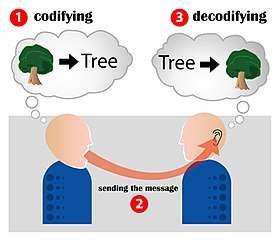Communication studies
| Communication |
|---|
| Portal · History |
| General aspects |
| Fields |
| Disciplines |
| Categories |
Communication studies or communication sciences is an academic discipline that deals with processes of human communication. There are three types of communication: verbal, involving listening to a person to understand the meaning of a message; written, in which a message is read; and nonverbal communication involving observing a person and inferring meaning.[1] The discipline encompasses a range of topics, from face-to-face conversation to mass media outlets, such as television broadcasting.
Communication studies shares with cultural studies an interest in how messages are interpreted through the political, cultural, economic, semiotic, hermeneutic, and social dimensions of their contexts. In political economics, communication studies examines how the politics of ownership affects content. Quantitative communication studies examines statistics in order to help substantiate claims.[2][3]
History
Communication science began in earnest when students of Wilbur Schramm—the founder of the Institute for Communications Research at the University of Illinois—namely David Berlo, came to Michigan State University and founded the first General Communication Arts department in the early 1950s.[4] Though there are other communication sciences departments elsewhere, Michigan State was the first department in the US that was dedicated solely to the study of communication sciences using a quantitative approach. It is still one of Michigan State's strongest programs and nationally ranked in the study of human communication.
Scope
Communication studies integrates aspects of both social sciences and the humanities. As a social science, the discipline overlaps with sociology, psychology, anthropology, biology, political science, economics, and public policy.[5] From a humanities perspective, communication is concerned with rhetoric and persuasion (traditional graduate programs in communication studies trace their history to the rhetoricians of Ancient Greece). Humanities approaches to communication often overlap with history, philosophy, english, and cultural studies.
In the United States
Undergraduate curricula aim to prepare students to interrogate the nature of communication in society, and the development of communication as a specific field.[6]
The National Communication Association (NCA) recognizes nine distinct but often overlapping sub-disciplines within the broader communication discipline: technology, critical-cultural, health, intercultural, interpersonal-small group, mass communication, organizational, political, rhetorical, and environmental communication. Students take courses in these subject areas. Other programs and courses often integrated in communication programs include journalism, film criticism, theatre, public relations, political science (e.g., political campaign strategies, public speaking, effects of media on elections), as well as radio, television, computer-mediated communication, film production, and new media.
In HK
Community College of City University(CCCU), there is a Division of Languages and Communication offers eight associate degree programmes in languages and communication. Graduates of ADs have good opportunities for further study at bachelor’s degree level, locally in Hong Kong and overseas. The Division also offers internationally recognized language assessment tests (PSC, for Putonghua; DELE, for Spanish; KLAT, for Korean; and TCF, for French). Summer English enhancement activities such as Summer Splash and the Grammar Drama Camp.
Professional associations
- American Journalism Historians Association (AJHA)
- Association for Business Communication (ABC)
- Association for Education in Journalism and Mass Communication
- Association for Teachers of Technical Writing (ATTW)
- Black College Communication Association (BCCA)
- Broadcast Education Association (BEA)
- Central States Communication Association (CSCA)
- Council of Communication Associations (CCA)
- European Association for the Teaching of Academic Writing (EATAW), the main European association for writing studies.
- European Communication Research and Education Association (ECREA), the main European association for communication studies.
- IEEE Professional Communication Society (PCS)
- International Association for Media and Communications Research (IAMCR), a large international association for communication studies.
- International Association of Business Communicators (IABC)
- International Communication Association is the main international association for communication studies, which combines an older focus on quantitatively based social science studies with newer critical and cultural studies of communicative phenomena.
- National Association for Media Literacy Education (NAMLE)
- National Communication Association (NCA): The main national professional organization covering many of the areas of communication studies in the U.S.
- Public Relations Society of America (PRSA)
- Rhetoric Society of America (RSA)
- Society for Cinema and Media Studies is the main organization for film studies oriented communication research.
- Society for Technical Communication (STC)
- University Film and Video Association is the principle organization for the study of motion picture production.
- Western States Communication Association (WSCA)
See also
References
- ↑ "Different Types of Communication and Channels". New Charter University. Archived from the original on March 10, 2016. Retrieved February 10, 2016.
- ↑ Hayes, Andrew F. (2005). Statistical Methods for Communication Science. Lawrence Erlbaum Associates, Inc. pp. 8–9.
- ↑ Caffarel-Serra, Carmen; Ortega, Félix; Gaitán, Juan-Antonio (2018-07-01). "Communication research in Spain: Weaknesses, threats, strengths and opportunities". Comunicar (in Spanish). 26 (56). doi:10.3916/c56-2018-06. ISSN 1134-3478.
- ↑ Rogers, Everett M. (2001), "The Department of Communication at Michigan State University as a Seed Institution for Communication Study", Communication Studies, 52 (3): 234–248
- ↑ Calhoun, Craig (2011). "Communication as Social Science (And More)" (PDF). International Journal of Communication. McGill University. 5: 1479–1496.
- ↑ Morreale, Sherwyn; Osborn, Michael; Pearson, Judy (2000). "Why Communication is Important: A Rationale for the Centrality of the Study of Communication" (PDF). Journal of the Association for Communication Administration. National Communication Association. 29: 1–25. Archived from the original (PDF) on 2017-01-05. Retrieved 2016-09-07.
Bibliography
- Carey, James. 1988 Communication as Culture.
- Cohen, Herman. 1994. The History of Speech Communication: The Emergence of a Discipline, 1914-1945. Annandale, VA: Speech Communication Association.
- Gehrke, Pat J. 2009. The Ethics and Politics of Speech: Communication and Rhetoric in the Twentieth Century. Carbondale, IL: Southern Illinois University Press.
- Packer, J. & Robertson, C, eds. 2006. Thinking with James Carey: Essays on Communications, Transportation, History.
- Peters, John Durham and Peter Simonson, eds. 2004. Mass Communication and American Social Thought: Key Texts 1919-1968.
- Wahl-Jorgensen, Karin 2004, 'How Not to Found a Field: New Evidence on the Origins of Mass Communication Research', Journal of Communication, September 2004.
